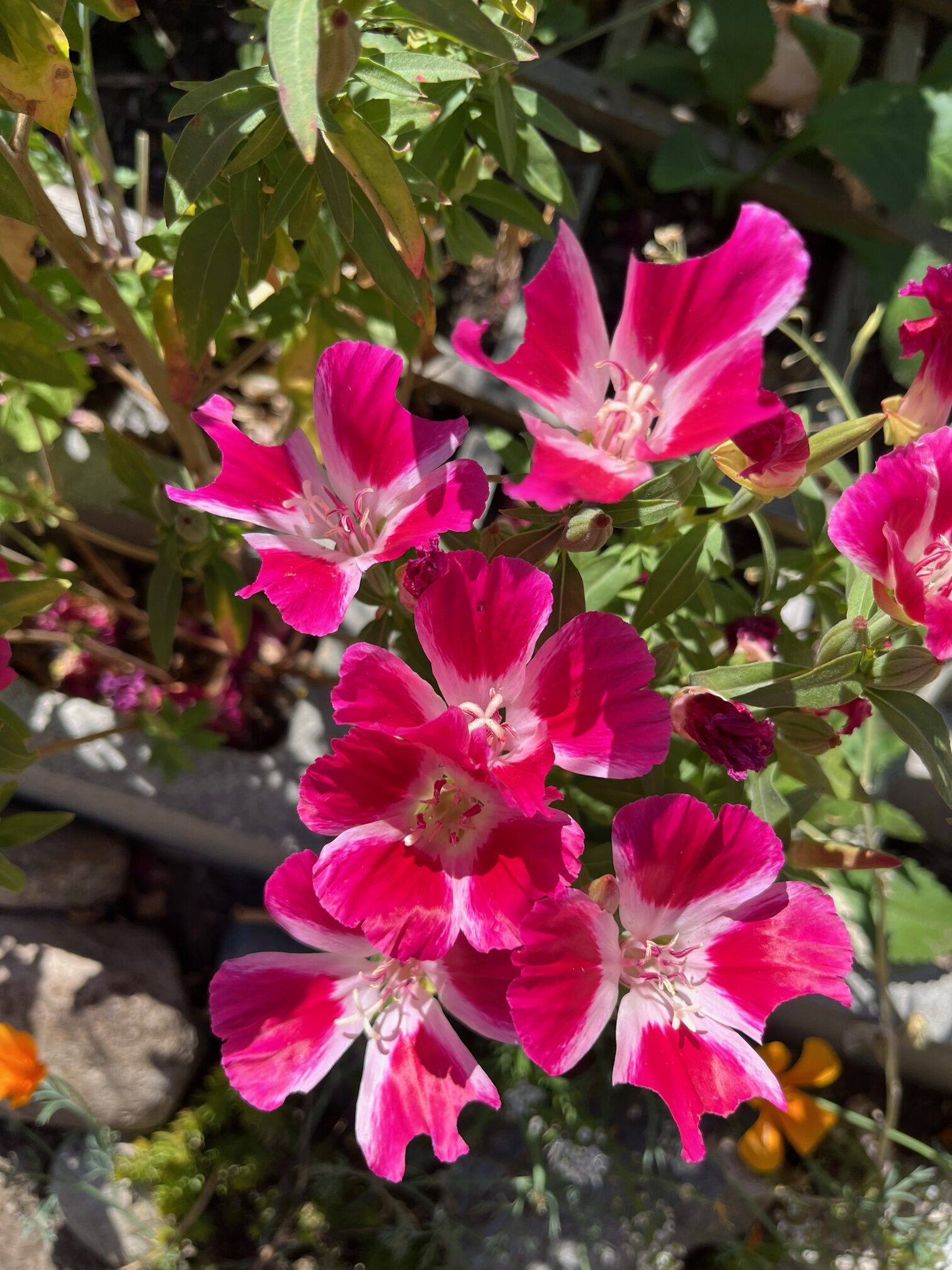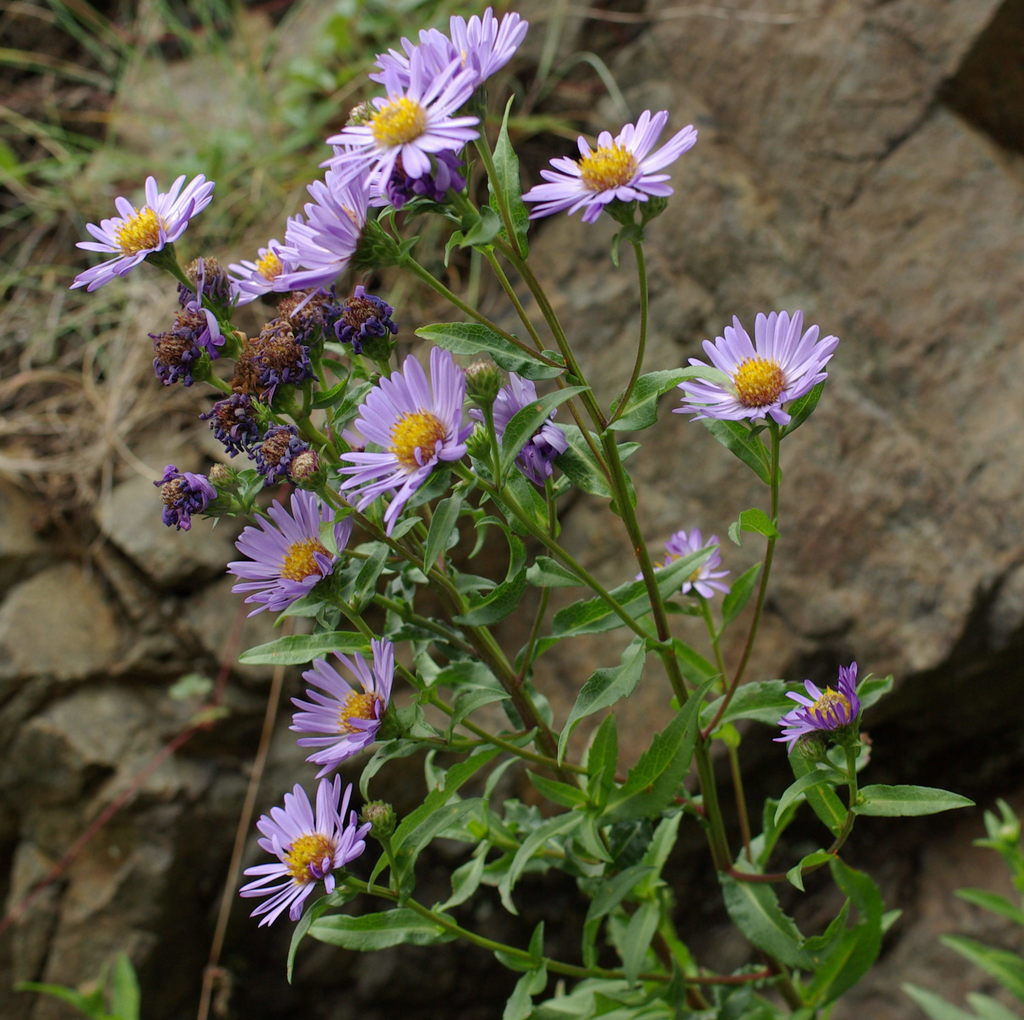Favorite Plants of
Pacific Plant People
Member Profile
Aaron Anderson
Oregon State University

Aaron Anderson is a PhD candidate in the Garden Ecology Lab at Oregon State University, and is broadly interested in how ecological function can be incorporated into urban and suburban landscapes. After dabbling in entomology, restoration ecology, and biological control, he became interested in studying urban systems. Aaron is fascinated by native beneficial insect conservation, especially in understanding how these species use urban green spaces as habitat to better inform how we manage these landscapes.

Farewell-to-spring 'Clarkia amoena'

Varileaf phacelia 'Phacelia heterophylla'
Douglas’ aster 'Symphotrichum subspicatum'
Natives for Habitat
Plant Family
Asteraceae
Genus
Symphyotrichum
Species
Douglas’ aster 'Symphotrichum subspicatum'
Douglas aster is an herbaceous perennial wildflower in the aster family. It usually occurs in wetlands and moist locations in the Klamath-Siskiyou area and will look its best with access to year-round moisture. It is typically a coastal species in the Klamath-Siskiyou, but can also occasionally be found inland.

Water Use
Irrigate less than once a month, once established very drought tolerant
Conditions When It Thrives
Typically found in damp locations near wetlands, but is very drought tolerant and will grow well with little supplemental irrigation once established.
Ecosystem Services
Provides late season pollen and nectar for native bees and beneficial insects. Its seeds provide fall food for birds.
Native To
Western North America
Geographic Range
Native to parts of Alaska, British Columbia to California, into Idaho and Montana.
Availability
Readily available at specialty native plant nurseries.
Height & Habit
It has an erect, spreading form, and grows 1-4 feet in height. Will spread via rhizomes.
Special Features
It was the most attractive native plant to pollinators in a Oregon State University Study.
Why They Love It
Douglas’ aster is a pollinator powerhouse. Not only does it attract a high abundance and richness of native bees, but it also supports a wide diversity of beneficial insects like predators and parasitoid wasps.
Seasonal Appearance/Dormancy
Late season bloomer with purple flowers. It has green stems, with many thin lance shaped leaves. In winter, it goes dormant and its dried stalks can provide habitat for stem nesting bees.
Advice
Grows in full sun to partial shade. Required minimal maintenance: irrigate less than once a month. Can grow aggressively; this plant can be contained by dead-heading flowers before seed set and digging up rhizomes as they spread.
Farewell-to-spring 'Clarkia amoena'
Natives for Habitat
Plant Family
Onagraceae
Genus
Clarkia
Species
Farewell-to-spring 'Clarkia amoena'
Farewell-to-spring is an erect or sprawling annual with showy, 4-petaled, cup-shaped, pink flowers occuring in the axils of several of the uppermost leaves. The large flowers are highlighted with a splash of bright red on each petal.

Water Use
Low water to establish, once grown it is drought tolerant.
Conditions When It Thrives
It grows in coastal hills, prairies, and inland grasslands and forests.
Ecosystem Services
Provides forage for a variety of native bee species, and its flowers are used as nesting material by leafcutter bees.
Native To
Western North America
Geographic Range
From British Columbia south through Washington, Oregon, down to the California Bay Area.
Availability
Readily available from native seed vendors.
Height & Habit
Grows to 1-3 feet tall.
Special Features
Leaf cutter bees (Megachilide sp.) cut circular discs from farewell-to-spring petals to line their nests with.
It’s common name is “farewell-to-spring” because it often blooms in late June or early July, signaling the end of spring and beginning of summer.
Why They Love It
It’s very easy to direct seed, and the pink flowers are unique and a great addition to a native pollinator meadow.
Seasonal Appearance/Dormancy
A fast growing annual that germinates in the spring, Colorful pink-purple flowers that bloom late spring into early summer. Thin leaved foliage adds interesting texture to a garden. Plants senesce at the end of the season.
Advice
Prefers partial to full sun. Readily self seeds, which can be advantageous in wildflower meadow plantings. To avoid this, pull plants before they go to seed.
Varileaf phacelia 'Phacelia heterophylla'
Natives for Habitat
Plant Family
Boraginaceae
Genus
Phacelia
Species
Varileaf phacelia 'Phacelia heterophylla'
This delightful biennial or short-lived perennial wildflower can grow 2′-4′ tall. The charming, coiled whitish-cream-colored, bell-shaped flowers bloom May-June, and like other phacelias, have protruding stamens. Varileaf phacelia usually produces just a single, tall flowering stem that can be either green or red.

Water Use
Drought tolerant.
Conditions When It Thrives
Found in dry, open habitats.
Ecosystem Services
Provides forage for a variety of native bee species, but is particularly popular with bumble bees.
Native To
Western North America
Geographic Range
Throughout the west, from British Columbia down to the higher elevation ranges of southern California.
Availability
Availability of seed can be limited, but it can be ordered from some native plant producers.
Height & Habit
Grows 1-3 feet tall. It has a central stem that grows erect, sometimes with multiple smaller stems.
Special Features
Highly attractive to a variety of bumble bee species.
Gardeners might be familiar with a similar species, Phacelia tanacetifolia, which has purple-blue flowers. This is native to the southwest United States, but has been introduced to other parts of the country as a cover crop where it can become weedy or invasive in some locations.
Why They Love It
The scorpiod cymes are unique looking, and the fuzzy leaves add texture to the garden.
Seasonal Appearance/Dormancy
Leaves and stems are gray-green colored and covered in small hairs. The flowers are a creamy white to light lavender, and as they open the inflorescence uncoils into a coiled or scorpiod shape. Flowers bloom late spring to summer. The plant dies back above ground. Grows as a biennial or weak perennial, an in some areas grows as an annual.
Advice
Grows well in full sun, and in moist to dry conditions once established. Grows well in nutrient poor soil, making it a good species for native pollinator gardens.
Douglas’ aster 'Symphotrichum subspicatum'
Natives for Habitat
Plant Family
Asteraceae
Genus
Symphyotrichum
Species
Douglas’ aster 'Symphotrichum subspicatum'
Douglas aster is an herbaceous perennial wildflower in the aster family. It usually occurs in wetlands and moist locations in the Klamath-Siskiyou area and will look its best with access to year-round moisture. It is typically a coastal species in the Klamath-Siskiyou, but can also occasionally be found inland.

Water Use
Irrigate less than once a month, once established very drought tolerant
Conditions When It Thrives
Typically found in damp locations near wetlands, but is very drought tolerant and will grow well with little supplemental irrigation once established.
Ecosystem Services
Provides late season pollen and nectar for native bees and beneficial insects. Its seeds provide fall food for birds.
Native To
Western North America
Geographic Range
Native to parts of Alaska, British Columbia to California, into Idaho and Montana.
Availability
Readily available at specialty native plant nurseries.
Height & Habit
It has an erect, spreading form, and grows 1-4 feet in height. Will spread via rhizomes.
Special Features
It was the most attractive native plant to pollinators in a Oregon State University Study.
Why They Love It
Douglas’ aster is a pollinator powerhouse. Not only does it attract a high abundance and richness of native bees, but it also supports a wide diversity of beneficial insects like predators and parasitoid wasps.
Seasonal Appearance/Dormancy
Late season bloomer with purple flowers. It has green stems, with many thin lance shaped leaves. In winter, it goes dormant and its dried stalks can provide habitat for stem nesting bees.
Advice
Grows in full sun to partial shade. Required minimal maintenance: irrigate less than once a month. Can grow aggressively; this plant can be contained by dead-heading flowers before seed set and digging up rhizomes as they spread.
Farewell-to-spring 'Clarkia amoena'
Natives for Habitat
Plant Family
Onagraceae
Genus
Clarkia
Species
Farewell-to-spring 'Clarkia amoena'
Farewell-to-spring is an erect or sprawling annual with showy, 4-petaled, cup-shaped, pink flowers occuring in the axils of several of the uppermost leaves. The large flowers are highlighted with a splash of bright red on each petal.

Water Use
Low water to establish, once grown it is drought tolerant.
Conditions When It Thrives
It grows in coastal hills, prairies, and inland grasslands and forests.
Ecosystem Services
Provides forage for a variety of native bee species, and its flowers are used as nesting material by leafcutter bees.
Native To
Western North America
Geographic Range
From British Columbia south through Washington, Oregon, down to the California Bay Area.
Availability
Readily available from native seed vendors.
Height & Habit
Grows to 1-3 feet tall.
Special Features
Leaf cutter bees (Megachilide sp.) cut circular discs from farewell-to-spring petals to line their nests with.
It’s common name is “farewell-to-spring” because it often blooms in late June or early July, signaling the end of spring and beginning of summer.
Why They Love It
It’s very easy to direct seed, and the pink flowers are unique and a great addition to a native pollinator meadow.
Seasonal Appearance/Dormancy
A fast growing annual that germinates in the spring, Colorful pink-purple flowers that bloom late spring into early summer. Thin leaved foliage adds interesting texture to a garden. Plants senesce at the end of the season.
Advice
Prefers partial to full sun. Readily self seeds, which can be advantageous in wildflower meadow plantings. To avoid this, pull plants before they go to seed.
Varileaf phacelia 'Phacelia heterophylla'
Natives for Habitat
Plant Family
Boraginaceae
Genus
Phacelia
Species
Varileaf phacelia 'Phacelia heterophylla'
This delightful biennial or short-lived perennial wildflower can grow 2′-4′ tall. The charming, coiled whitish-cream-colored, bell-shaped flowers bloom May-June, and like other phacelias, have protruding stamens. Varileaf phacelia usually produces just a single, tall flowering stem that can be either green or red.

Water Use
Drought tolerant.
Conditions When It Thrives
Found in dry, open habitats.
Ecosystem Services
Provides forage for a variety of native bee species, but is particularly popular with bumble bees.
Native To
Western North America
Geographic Range
Throughout the west, from British Columbia down to the higher elevation ranges of southern California.
Availability
Availability of seed can be limited, but it can be ordered from some native plant producers.
Height & Habit
Grows 1-3 feet tall. It has a central stem that grows erect, sometimes with multiple smaller stems.
Special Features
Highly attractive to a variety of bumble bee species.
Gardeners might be familiar with a similar species, Phacelia tanacetifolia, which has purple-blue flowers. This is native to the southwest United States, but has been introduced to other parts of the country as a cover crop where it can become weedy or invasive in some locations.
Why They Love It
The scorpiod cymes are unique looking, and the fuzzy leaves add texture to the garden.
Seasonal Appearance/Dormancy
Leaves and stems are gray-green colored and covered in small hairs. The flowers are a creamy white to light lavender, and as they open the inflorescence uncoils into a coiled or scorpiod shape. Flowers bloom late spring to summer. The plant dies back above ground. Grows as a biennial or weak perennial, an in some areas grows as an annual.
Advice
Grows well in full sun, and in moist to dry conditions once established. Grows well in nutrient poor soil, making it a good species for native pollinator gardens.
